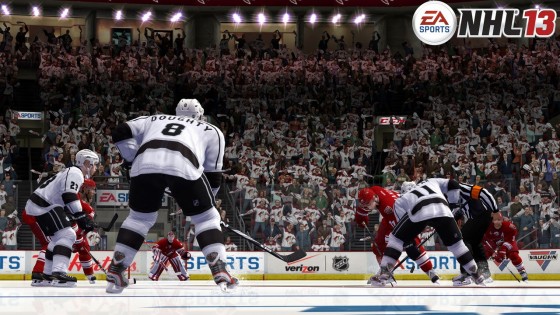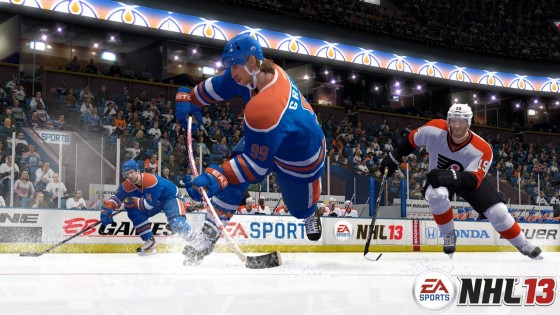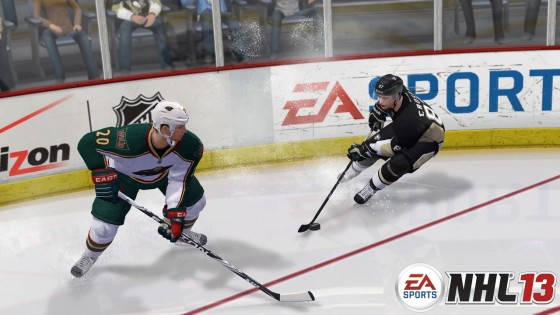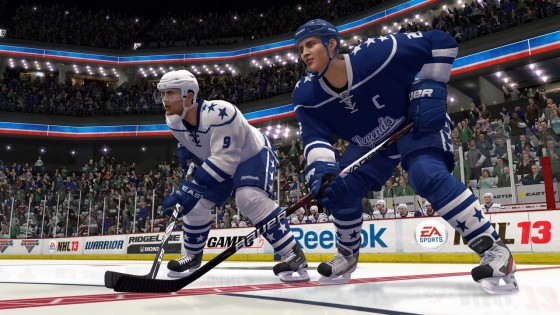

With the new skating engine, prominent poke-checking and super-powered goalies, the powerplay looks a little bit different in NHL 13. A lot of strategies from previous years will still find success here and there, but the emphasis has definitely been placed on perimeter play — or at the very least, creating an opening through a cycle so that you can get to the slot.
To start with, the strategies on offer during the powerplay remain the same as in previous years, with the “overload” highlighting skilled forwards, the “umbrella” emphasizing play off the half-boards, and the “shooting” formation for booming point shots. There is also a slider to set the AI tendency for carrying or dumping the puck on the powerplay, which can be useful when you are locked to a position or playing in coach mode. You can also still customize defensive formation on the PP, with “collapsing,” “staggered” or “tight point” options.

Strategies for the CPU
1) The CPU on the harder difficulties will pressure you at the point, but they actually get more aggressive on the half-boards or when you try to carve into the corner. You'll likely have some freedom on the wall if you burst into the zone, but you'll only get one or two seconds to make a decision. If you want to head behind the net, make sure you do it quickly after entering the zone.
2) If you want to set up a shooting powerplay, be sure to set your strategy that way and play catch with the puck either on the half-boards or at the point. You might get poke-checked the odd time, but it's pretty easy to carve your player away from the CPU and create a passing lane to the other d-man. Shots will get through from the point if you're patient and create openings through your patient passing. Redirects and rebounds will be common if you pull the penalty killers out of the way with a couple of quick passes at the point.
3) For one-timers, consider abandoning the cross-creases of previous years, as the AI success rate for pass interception is very high, and the goalies get to almost all of them now. Consider getting behind the net and waiting for a teammate to get to the slot. These behind-the-net opportunities for one-timers can generate door-step chances if you play your cards right.

Strategies for 1-on-1 Games
1) For a lot of players, the likely strategy when shorthanded will be to either crowd you at the point with a lunging forward or stay passive with a d-man and look for poke checks and shot blocks. If they're giving you the space for shots at the point, take them and look for rebounds. Or if they're really back on their heels, drive for the slot with your d-man and look for a screened wrister.
2) If the opposing player is getting aggressive on your zone entry, consider dumping the puck around the boards or straight to the opposite corner. Then quickly switch to your other winger to move in for it. The dump-and-chase remains a decent strategy this year, and if you come up with the puck, you have a lot of options, especially since the other player will likely be chasing at that point.
3) When faced with players who are trying to crush you on the half-boards or behind the net, don't forget that the Y button (or Triangle button) will put you into boardplay. This is a great way for dodging overzealous checkers. At the very worst, you're into the boardplay mechanic, where you can possibly kick it to a teammate, and at best, you can actually evade the checker completely, freeing up slot chances and one-timers.

Strategies for the EASHL
1) Since the short-side wrister is working at a high frequency right now, I've found one of the best strategies when playing with my team is win a draw to the right-side defenseman (when having a face-off on the right side) and wait for the hyperactive left winger to come at you. It's almost automatic to evade them on the half-boards, and this sets up a perfect top corner shot in the slot. I've found success with this even using defenders with 65 ratings for wrist shot accuracy and power.
2) While you can look for the lateral one-timer opportunities more often against EASHL teams (since they're prone to getting pulled out of position more), it can be beneficial to use the back of the net for wraparounds, behind-the-net passes and one-timers from the other side. Unless the defense is really active, you'll have opportunities back there. And if they do get frisky, you can cycle it back to your defender at the point.
3) As in previous years, screens and deflections during team games remain a key. You'll want to have power forwards and grinders (and honestly just about any other forwards that are available) up in front of the net engaging defenders. It will lock the defenders to the spot temporarily, and you'll have a higher chance of deflections and rebound goals. There's a real art to finding the right distance for screening the goalie, but once you have it, defenders will be able to sneak wristers and slappers passed the helpless goalie.

Final Thoughts
Having a healthy respect for the lightning-fast goalies and buffed poke check will help you get to the right areas on the powerplay, no matter who you're playing against. Using the whole ice is always key, and exploiting the new momentum of the skating engine to create stop-and-go opportunities is vital for connecting on passes.
What strategies are you finding to be the most effective on the powerplay in NHL 13?




 OS Tip of the Day: Know the Pitcher If You Want to Steal
OS Tip of the Day: Know the Pitcher If You Want to Steal NCAA Passing Strategy Part Two
NCAA Passing Strategy Part Two NBA 2K12: Managing the Heat
NBA 2K12: Managing the Heat NHL 13: Powerplay Strategies
NHL 13: Powerplay Strategies NHL 09: How to Become a Better EASHL Teammate
NHL 09: How to Become a Better EASHL Teammate